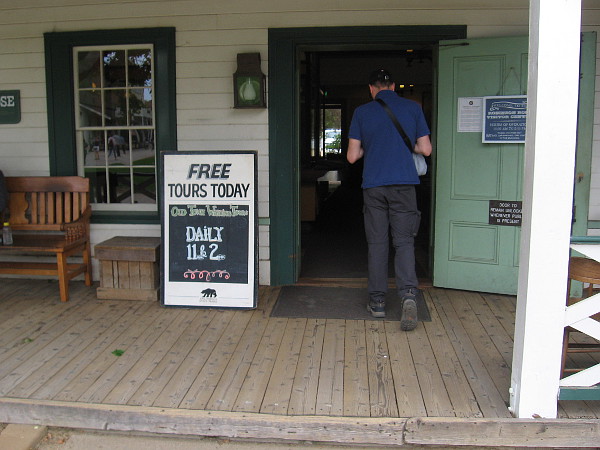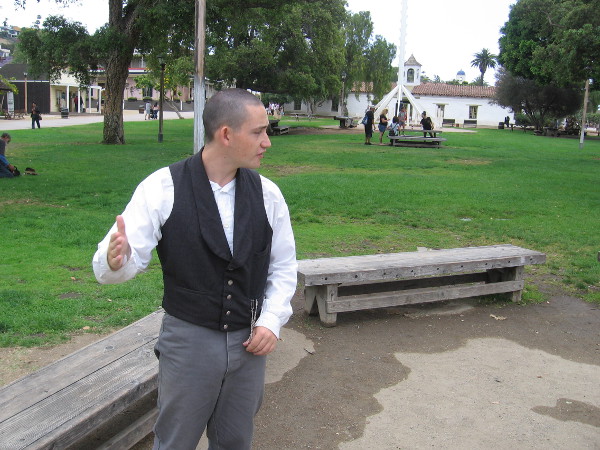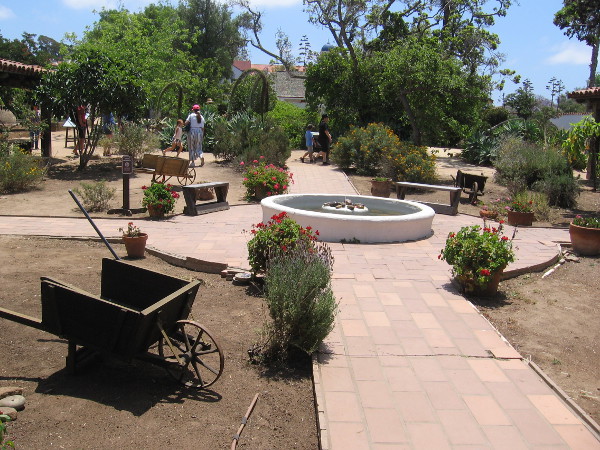
A free walking tour of Old Town San Diego State Historic Park is available every day at 11 am and 2 pm. The tours meet in front of the Robinson-Rose House Visitor Center, at the northwest end of Old Town’s large grassy plaza. (UPDATE! In late 2022, post-COVID, the tours were being offered Thursday and Friday at 11 am. Times are subject to change!)
When I visit Old Town San Diego, I’ll sometimes join the walking tour while it’s in progress. Last weekend I happened to be in front of the Robinson-Rose House right at eleven o’clock, so I decided to enjoy the full one hour tour!
During this easy walk a guide in period costume provides fascinating information about San Diego’s early history. Several different periods are covered, from the Spanish mission period, to the Mexican rancho period, to the early American period. The main interpretive period is 1821 to 1872.
Among the following photos are a few interesting bits of history…




The Native American Kumeyaay village of Cosoy was located where Old Town San Diego’s plaza was established. Before the San Diego River was diverted in 1877, its water ran very close to Old Town and was an integral part of the life of early people in our desert-like Southern California coastal region.



When Mexico won its independence from Spain in 1821, the Spanish soldiers of the nearby San Diego Presidio switched their allegiance to Mexico, which couldn’t afford to pay them. For their service, they were given land at the foot of Presidio Hill, where many soldiers and their families built houses. That is how Old Town started.
You can learn more about La Casa de Machado y Silvas and the fascinating Commercial Restaurant museum here.



You might notice the flagpole at the center of Old Town’s Plaza looks a lot like a ship’s mast. Because originally it was!
When an American force under Captain Samuel F. DuPont sailed into San Diego Bay in 1846 to take control of Old Town unopposed, the plaza had no flagpole, because most of the independent-minded Californios who lived here didn’t feel a strong attachment to Mexico. So a ship’s mast was used to raise the flag of the United States.
You can see a bronze plaque commemorating the event here.
You can learn more about the old Spanish cannon that sits in the middle of Old Town’s plaza near the flagpole here.


A vacant area of ground beside the Colorado House (now home of the Wells Fargo Museum) is where the Franklin House hotel used to stand. It was Old Town’s only three story building, notable for its relative elegance and its baths.
The Franklin House was destroyed during the great fire of 1872 along with several adjacent buildings including Old Town’s courthouse, ensuring that San Diego’s future would be located in Alonzo Horton’s New Town, which was then called Horton’s Addition.
To learn more about San Diego’s first courthouse, click here.
To learn more about Colorado House and the Wells Fargo Museum, click here.



Our tour group then walked over to Casa de Machado y Stewart. We learned many things, including the fact that the fancier china seen on the dining table came by merchant ships that crossed the Pacific from Asia.
The more simple items like candlesticks were made by local blacksmiths. Because iron was rare in San Diego, harpoons from a brief period of whaling in San Diego Bay were used to make a variety of furnishings and household utensils.
You can learn more about the Casa de Machado y Stewart here.
You can learn about Old Town’s blacksmith shop here.
We also learned that the art of brick-making was introduced to Old Town by members of the Mormon Battalion, whose arrival in San Diego you can learn about here.






The walking tour concluded inside the courtyard of La Casa de Estudillo. In many respects, this beautiful house is the centerpiece of Old Town San Diego. Two past blog posts provide a great deal of information about La Casa de Estudillo.
You can peer into the house’s restored rooms and learn about their history here.
You can learn how a wildly popular novel saved this historic building from destruction here!

Finally, to enjoy a good overview of San Diego’s early history, I recommend a visit to Old Town’s excellent McCoy House Museum. You can check out my blog post featuring its many exhibits by clicking here!
…
I live in downtown San Diego and love to walk around with my camera! You can follow Cool San Diego Sights via Facebook or Twitter!
You can easily explore Cool San Diego Sights by using the search box on my blog’s sidebar. Or click a tag! There are thousands upon thousands of photos for you to enjoy!
One thought on “A free walking tour of Old Town San Diego.”